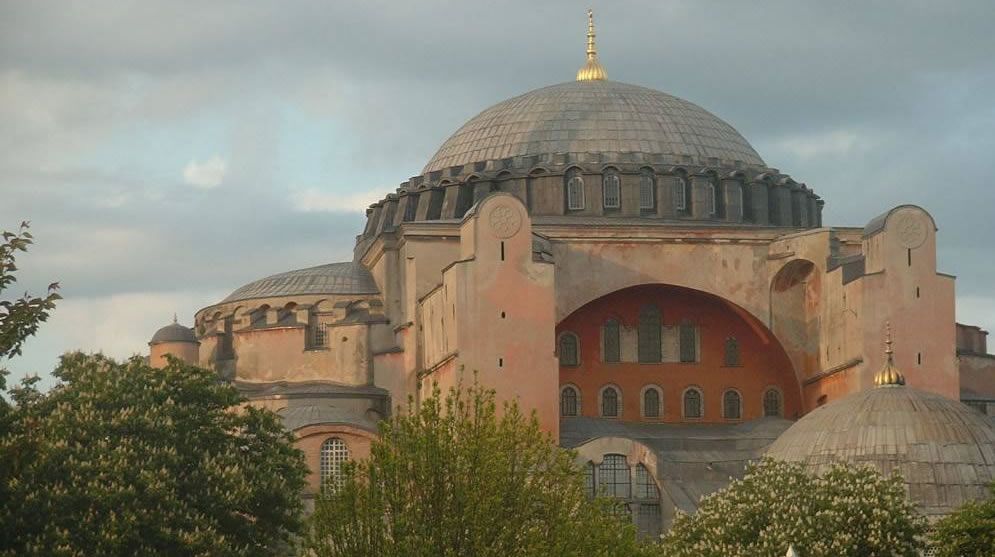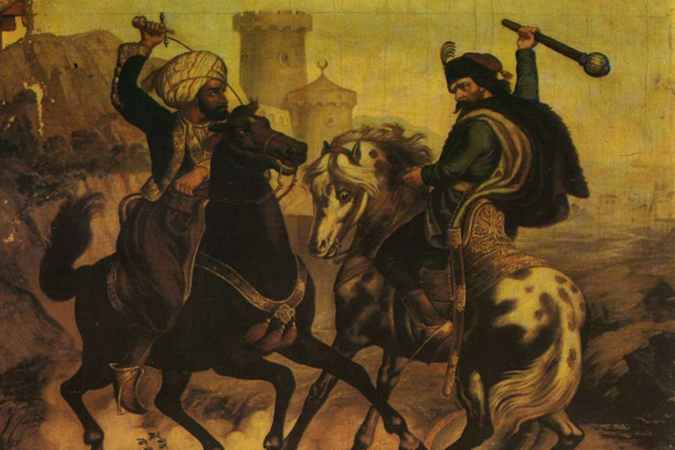It is usually considered that legends and myths are actually fictions and constructions that, true, start from historical events but do not get conveyed factually. However, they carry a spirit and a message that, although seemingly unfounded, contains an ethos that, more than any other fact, influences the formation of ethical and spiritual attitudes in the nation to which it belongs.

When the Turks penetrated Constantinople through a secret gate, which the Greeks, out of negligence, forgot to close, and when a riot and defeat of the defense army ensued, the people became frightened and confused and began to flock to Agia Sophia.
The common people in besieged Constantinople believed in a prophecy, that the Turks would not penetrate further than to the pillar of Constantine, which was in the way of the Turks before St. Sophia. The people believed that an angel of God would appear before the Turks in that place, that he would hand over the sword to an unknown man from the people and that he would immediately expel the Turks from Constantinople and Europe, and drive them into the interior of Asia. That is why everyone turned to Agia Sophia; so everyone was waiting for the hour when the Angel would appear; and in that expectation the whole world prayed to God. In his ceremonial church robes, the patriarch served the service among the astonished and frightened people.
At that moment, the Turkish axes broke down the door and the Turks rushed to Agia Sophia. Blood splattered on the consecrated spaces of St. Sophia, that unsurpassedly magnificent example of ancient architecture, and the patriarch laid down his life in the temple of God in service and prayer.
That’s what history says.
But the folk tale tells how at the moment when the unbelievers went to the patriarch and the holy sacrament of communion, the wall opened before the patriarch and the holy sacrament, how the patriarch entered that wall with the holy sacrament, and how the wall reassembled behind him. And when the Turks are expelled from Constantinople, the story goes, that wall will open, the patriarch will come out with the holy sacrament of communion and will finish the service that he started more than four centuries ago.
E. de Amichis tells us this story in his Constantinople, in the chapter on Agia Sophia. “At that moment,” he said, “when the conquerors in Agia Sophia showed up, a Greek bishop, who was serving, came out of the altar, climbed into the great gallery, and at which point the soldiers ran after him, he disappeared through a small door, which is walled up behind him. The soldiers started hitting the wall with all their might, but only a trace of their weapon was visible on the wall. They summoned the masons, but after a whole day of futile torment with picks and buzzards, there was nothing they could do. Then all the masons of Constantinople changed in that work, and all fell emaciated from the futile strain in front of that strange wall. On the day when the desecrated church returns to Christian service, the wall will be opened, and then the Greek bishop will come out of it in his bishop’s robes, with Holy Chalise in his hand, with a happy face, and stepping on the altar,
he will continue the service of God in this same place where he interrupted it. “
Thus, the folk tale in this region and in the capital of the Balkan Peninsula, in its poetic spirit, clothed the tragic end of the Roman Empire and the Christian government in Constantinople.
Who would not remember similar stories in the Serbian people during these stories of the Greek people?

Who doesn’t remember the Serbian prince Marko Kraljevic, who, according to the Serbian story, didn’t die but just fell asleep; who does not remember Marko’s sword stuck in the rock, Marko’s horse Sharac, who eats moss, and the prophecy that Marko will wake up, pull the sword out of the rock and let his horse Sharac eat moss, and that then the Serbs will be freed and become what they are were.
Who doesn’t remember the same thing being said in Montenegro about Ivan Crnojevic? Who doesn’t think of the stories about despot Stefan, who is said to have expelled the Turks across the sea once, rushed after them with a mace and shouted: “When this mace comes out uselessly, then the Turks might return here!”. Who doesn’t think of the stories about the construction of the monastery Ravanica and the Battle of Kosovo, which also state the fateful provision that unbelievers would rule?
Thought is indeed one, and forms are different. But in different forms of the same basis, which develops from the same history, there are again some differences. Greek forms tied more to religion, they are more imbued with religious breath; Serbs are more national, they show more national political factors. For the Greeks, the church has the first place – for the Serbs, the second place: for the Greeks, it is a pure representation of the faith – for the Serbs, it has already been transformed into destiny. There is no mention of heroic resistance there, but for Serbs it is the main thing. I would say that these differences clearly stand out at this point; but even if it seems that they speak for themselves, it may be the spirit of that time, it would be reckless to look for the same signs in the later Serbian and Greek history. It is as if later times smoothed out the differences in understanding and poetic thinking of the 15th century.
Stojan Novakovich
BALKAN ISSUES, (Under the Walls of Constantinople, pp. 107-109) Institute for Textbooks, Belgrade, 2000.

